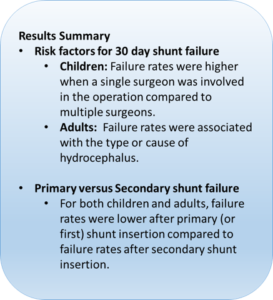Risk Factors for Ventriculoperitoneal (VP) Shunt Failure in Children and Adults
By: Aparna Srinivasan
Aparna Srinivasan
Background:
VP shunt revisions can be very stressful for patients living with hydrocephalus. For many families, it may seem that, once you have one shunt revision, you are more likely to have multiple revisions. This is why researcher Anderson and his colleagues from Leeds, United Kingdom conducted a study to determine 1) what specific factors are associated with VP shunt failure within 30 days of its placement and 2) if secondary shunts fail more often than primary (or first) shunts.
Methods:
The authors of this study reviewed data from over a five year period in both pediatric and adults patients who had their shunt placed at this institution. They counted the number of shunts that had failed within 30 days of placement, and, from this data, they calculated the 30 day shunt failure rate.
Results:
For pediatric patients, the number of surgeons involved in the procedure was identified as a risk factor for 30-day shunt outcomes: Two groups were compared for the analysis (multiple surgeons vs. single surgeon). When a single surgeon was in the operating room, the 30 day shunt failure rate increased from 14.1% (multiple surgeons) to 27.7% (single surgeon).
For adult patients, the cause of hydrocephalus was identified as a risk factor for 30-day shunt outcomes The lowest failure rate was seen in patients with congenital hydrocephalus (5.1%) and Normal Pressure Hydrocephalus (9.4%). The highest failure rate was seen in patients whose shunts were placed as a result of a brain infection (postinfectious hydrocephalus, 44.1%).
The authors also compared the failure rates of primary (first) shunts to failure rates of secondary (revised) shunts.
- The 30-day shunt failure rate in children was 8.8% for primary shunts and 23.4% for secondary shunts.
- The 30-day shunt failure rate in adults was 17.7% for primary shunts and 25.6% for secondary shunts.
In both the pediatric and adult population, the choice of valve and shunt catheter position did not affect the 30 day shunt failure rate.
The purpose of this study was to determine the rate of shunt failure in both children and adults in a single institution over a five year period. The risk factors identified by the authors need to be further investigated to determine if the results are consistent across many hospitals or specific to this one hospital.
For access to the original article go here: https://www.ncbi.nlm.nih.gov/pubmed/29521592
Author Aparna Srinivasan will be a high school senior this fall. She enjoys playing the flute in her community orchestra and the school marching band. In the future, she hopes to pursue a career in medicine.
